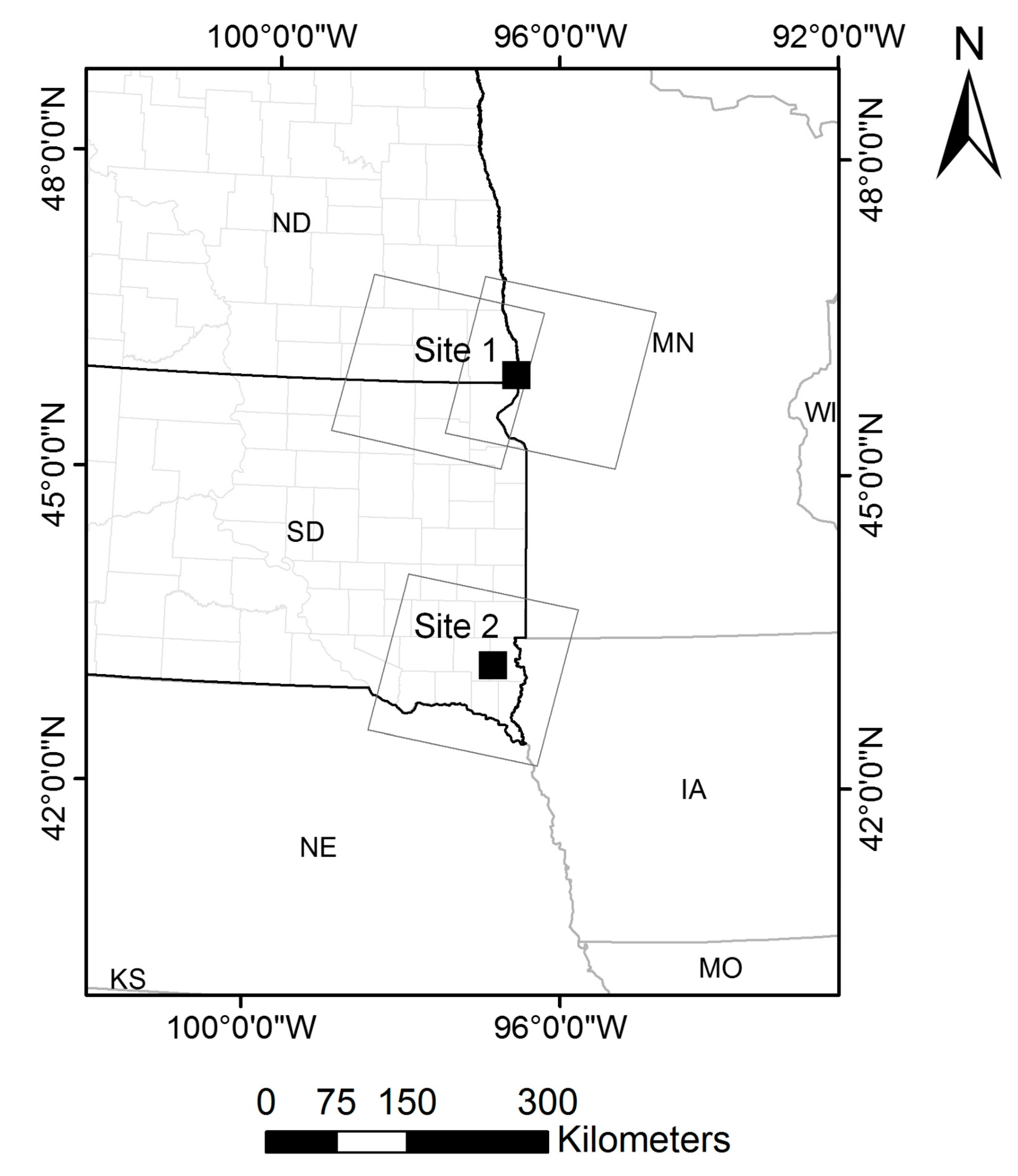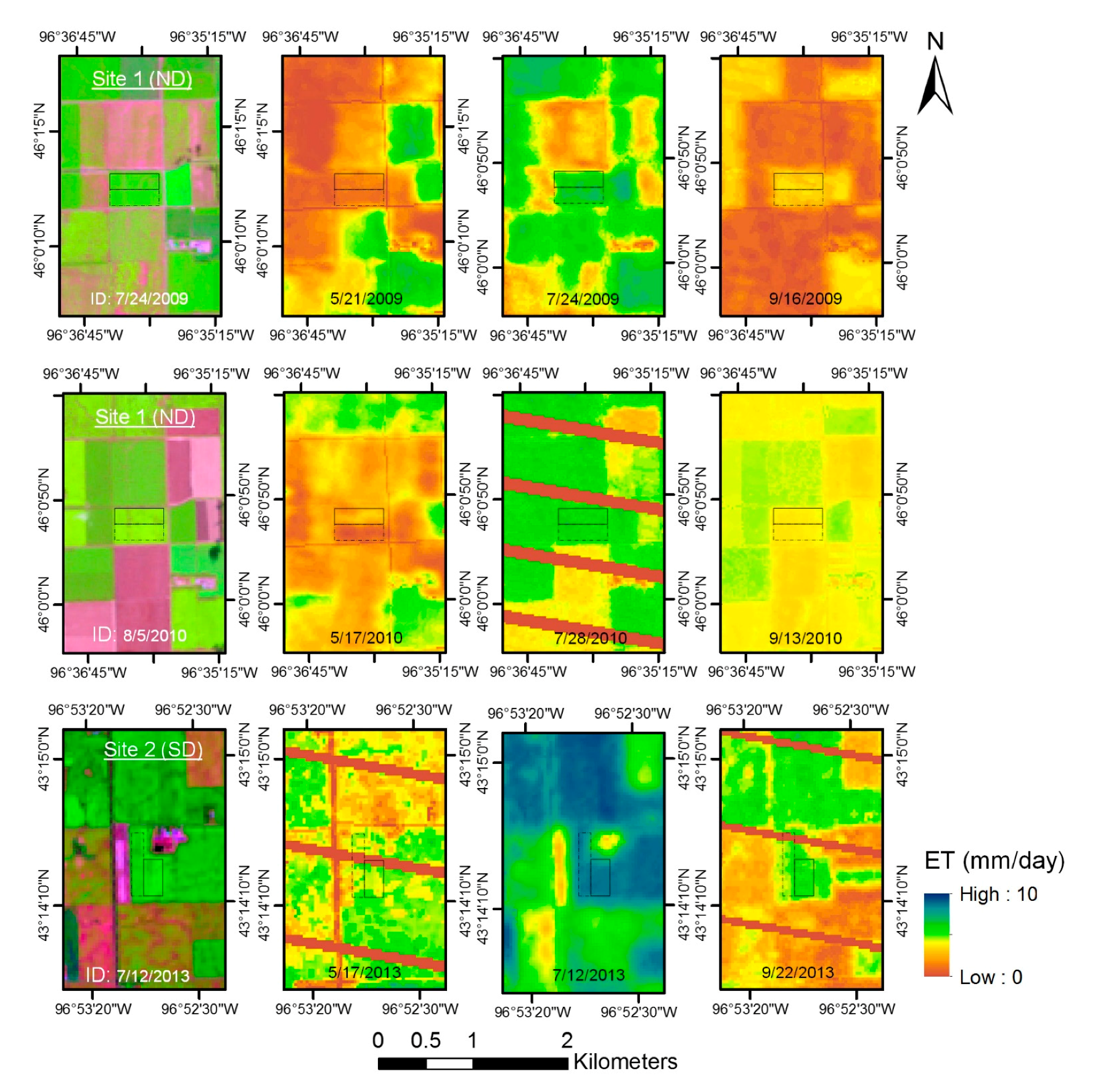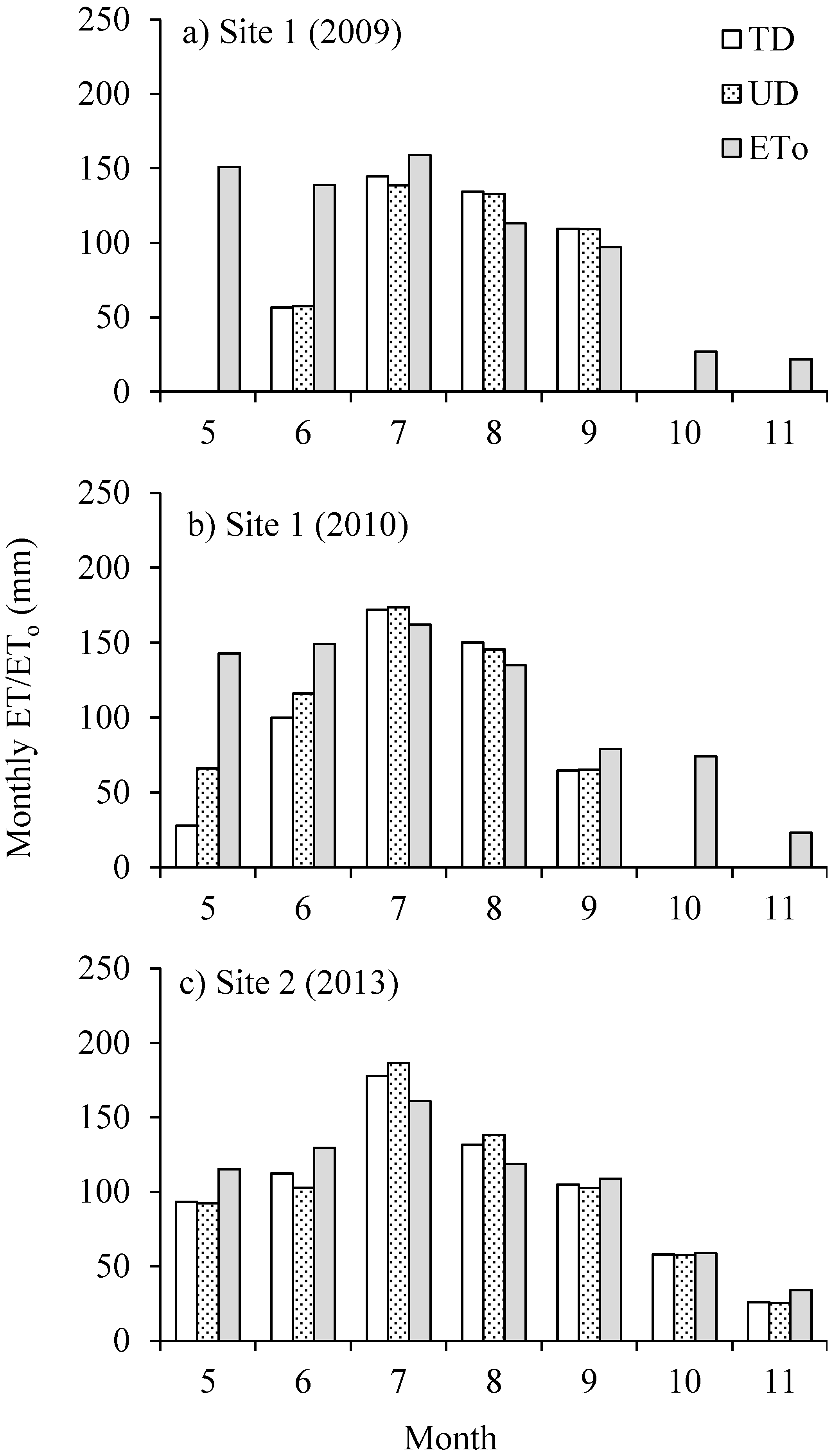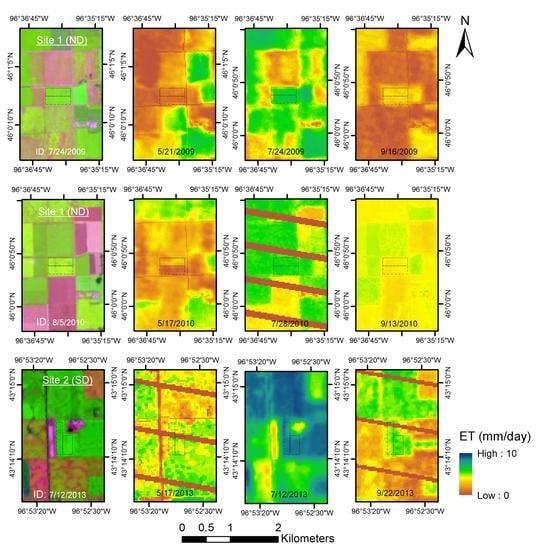Estimating Impacts of Agricultural Subsurface Drainage on Evapotranspiration Using the Landsat Imagery-Based METRIC Model
Abstract
:1. Introduction
2. Materials and Methods
2.1. Study Sites and Data
2.2. METRIC Evapotranspiration
2.3. Monthly and Seasonal ET Estimation
3. Results
3.1. Comparison of Daily ET
3.2. Monthly and Seasonal ET
4. Discussion
5. Conclusions
Acknowledgments
Author Contributions
Conflicts of Interest
References
- Skaggs, R.W.; Breve, M.A.; Gilliam, J.W. Hydrologic and water quality impacts of agricultural drainage. Crit. Rev. Environ. Sci. Technol. 1994, 24, 1–32. [Google Scholar] [CrossRef]
- Pavelis, G.A. Farm Drainage in the United States: History, Status, and Prospects; United States Department of Agriculture, Economic Research Service: Washington, DC, USA, 1987. [Google Scholar]
- Natural Resources Conservations Service—Web Soil Survey. Available online: http://websoilsurvey.nrcs.usda.gov/app/HomePage.htm (accessed on 8 May 2014).
- Allen, R.G.; Pereira, L.S.; Raes, D.; Smith, M. Crop Evapotranspiration—Guidelines for Computing Crop Water Requirements—FAO Irrigation and Drainage Paper 56; Food and Agriculture Organization of the United Nations: Rome, Italy, 1998. [Google Scholar]
- Tasumi, M.; Allen, R.G.; Trezza, R.; Wright, J.L. Satellite-Based Energy Balance to Assess within-Population Variance of Crop Coefficient Curves. J. Irrig. Drain. Eng. 2005, 131, 94–109. [Google Scholar] [CrossRef]
- Gowda, P.H.; Chavez, J.L.; Colaizzi, P.D.; Evett, S.R.; Howell, T.A.; Tolk, J.A. Remote sensing based energy balance algorithms for mapping ET: Current status and future challenges. Trans. Am. Soc. Agric. Biol. Eng. 2007, 5, 1639–1644. [Google Scholar]
- Kalma, J.D.; McVicar, T.R.; McCabe, M.F. Estimating Land Surface Evaporation: A Review of Methods Using Remotely Sensed Surface Temperature Data. Surv. Geophys. 2008, 29, 421–469. [Google Scholar] [CrossRef]
- Allen, R.; Irmak, A.; Trezza, R.; Hendrickx, J.M.H.; Bastiaanssen, W.; Kjaersgaard, J. Satellite-based ET estimation in agriculture using SEBAL and METRIC. Hydrol. Process. 2011, 25, 4011–4027. [Google Scholar] [CrossRef]
- Bastiaanssen, W.G.M. Regionalization of Surface Flux Densities and Moisture Indicators in Composite Terrain: A Remote Sensing Approach under Clear Skies in Mediterranean Cimates. Ph.D. Thesis, CIP Data Koninklijke Bibliotheek, Den Haag, The Netherlands, 1995. [Google Scholar]
- Allen, R.G.; Tasumi, M.; Trezza, R. Satellite-based energy balance for mapping evapotranspiration with internalized calibration (METRIC)—Model. J. Irrig. Drain. Eng. 2007, 133, 380–394. [Google Scholar] [CrossRef]
- Allen, R.G.; Tasumi, M.; Morse, A.; Trezza, R.; Wright, J.L.; Bastiaansseen, W.; Kramber, W.; Lorite, I.; Robison, C. Satellite-based energy balance for mapping evapotranspiration with internalized calibration (METRIC)–Applications. J. Irrig. Drain. Eng. 2007, 133, 395–406. [Google Scholar] [CrossRef]
- Su, Z. The surface energy balance systems (SEBS) for estimation of turbulent fluxes. Hydrol. Earth Syst. Sci. 2002, 6, 85–99. [Google Scholar] [CrossRef]
- Anderson, M.C.; Norman, J.M; Diak, G.R.; Kustas, W.P.; Mecikalski, J.R. A two-source time-integrated model for estimating surface fluxes using thermal infrared remote sensing. Remote Sens. Environ. 1997, 60, 195–216. [Google Scholar] [CrossRef]
- Senay, G.B.; Bohms, S.; Singh, R.K.; Gowda, P.H.; Velpuri, N.M.; Alemu, H.; Verdin, J.P. Operational evapotranspiration mapping using remote sensing and weather datasets: A new parameterization for the SSEB approach. J. Am. Water Resour. Assoc. 2013, 49, 577–591. [Google Scholar] [CrossRef]
- Jin, C.-X.; Sands, G.R. The Long–Term Field–Scale Hydrology of Subsurface Drainage Systems in a Cold Climate. Trans. Am. Soc. Agric. Biol. Eng. 2003, 46, 1011–1021. [Google Scholar]
- Youssef, M.A.; Skaggs, R.W.; Kelly, R.T.; Ahmed, M.A.; Jaynes, D.B. Drainmod-Simulated Performance of Drainage Water Management across the U.S. Midwest. In Proceedings of the 9th International Drainage Symposium Held Jointly with CIGR and CSBE/SCGAB, St. Joseph, MI, USA, 13–16 June 2010; ASABE: St. Joseph, MI, USA, 2010. [Google Scholar]
- Konyha, K.D.; Skaggs, R.W.; Gilliam, J.W. Effects of drainage and water-management practices on hydrology. J. Irrig. Drain. Eng. 1992, 118, 807–819. [Google Scholar] [CrossRef]
- Skaggs, R.W. A Water Management Model for Shallow Water Table Soils; Water Resources Research Institute of the University of North Carolina Report 134; Water Resources Research Institute of the University of North Carolina: Raleigh, NC, USA, 1978. [Google Scholar]
- Bottcher, A.B.; Monke, E.J.; Huggins, L.F. Nutrient and sediment loadings from a subsurface drainage system. Trans. Am. Soc. Agric. Eng. 1981, 24, 1221–1226. [Google Scholar] [CrossRef]
- Skaggs, R.W.; Gilliam, J.W. Effect of drainage system design and operation on nitrate transport. Trans. Am. Soc. Agric. Eng. 1981, 24, 929–934. [Google Scholar] [CrossRef]
- Irwin, R.W.; Whiteley, H.R. Effects of land drainage on stream flow. Can. Water Resour. J. 1983, 8, 88–103. [Google Scholar] [CrossRef]
- Whiteley, H.R.; Ghate, S.R. Sources and amounts of overland runoff from rain on three small watersheds. Can. Agric. Eng. 1979, 21, 1–7. [Google Scholar]
- Baden, W.; Eggelsman, R. The hydrologic budget of the highbogs in the Atlantic region. In Proceedings of the Third International Peat Congress, Quebec, QC, Canada, 18–23 August 1968. [Google Scholar]
- Robinson, M. Impact of Improved Land Drainage on River Flows; Institute of Hydrology: Wallingford, Oxon, UK, 1990. [Google Scholar]
- Schilling, K.E.; Helmers, M. Effects of subsurface drainage tiles on streamflow in Iowa agricultural watersheds: Exploratory hydrograph analysis. Hydrol. Process. 2008, 22, 4497–4506. [Google Scholar] [CrossRef]
- Rahman, M.M.; Lin, Z.; Jia, X.; Steele, D.D.; DeSutter, T.M. Impact of subsurface drainage on streamflows in the Red River of the North basin. J. Hydrol. 2014, 511, 474–483. [Google Scholar] [CrossRef]
- Hoogestraat, G.K.; Stamm, J.F. Climate and Streamflow Characteristics for Selected Streamgages in Eastern South Dakota, Water Years 1945–2013; United States Geological Survey Scientific Investigations Report 2015-5146; U.S. Geological Survey: Reston, VA, USA, 2015. [Google Scholar]
- Rijal, I.; Jia, X.; Zhang, X.; Steele, D.D.; Scherer, T.F.; Akyuz, A. Effects of Subsurface Drainage on Evapotranspiration for Corn and Soybean Crops in Southeastern North Dakota. J. Irrig. Drain. Eng. 2012, 138, 1060–1067. [Google Scholar] [CrossRef]
- Yang, Y.; Anderson, M.; Gao, F; Hain, C.; Kustas, W.; Meyers, T.; Crow, W.; Finocchiaro, R.; Sun, L.; Yang, Y. Impact of Tile Drainage on Evapotranspiration in South Dakota, USA, Based on High Spatiotemporal Resolution Evapotranspiration Time Series from a Multisatellite Data Fusion System. IEEE J.-STARS 2017, 10, 2550–2564. [Google Scholar] [CrossRef]
- Environmental and Water Resources Institute of the American Society of Civil Engineers (ASCE-EWRI). The ASCE Standardized Reference Evapotranspiration Equation; Report of the ASCE-EWRI Task Committee on Standardization of Reference Evapotranspiration; ASCE: Reston, VA, USA, 2005. [Google Scholar]
- Santos, C.; Lorite, I.J.; Allen, R.G.; Tasumi, M. Aerodynamic Parameterization of the Satellite-Based Energy Balance (METRIC) Model for ET Estimation in Rainfed Olive Orchards of Andalusia, Spain. Water Resour. Manag. 2012, 26, 3267–3283. [Google Scholar] [CrossRef]
- Trezza, R.; Allen, R.G.; Tasumi, M. Estimation of actual evapotranspiration along the Middle Rio Grande of New Mexico using MODIS and Landsat imagery with the METRIC model. Remote Sens. 2013, 5, 5397–5423. [Google Scholar] [CrossRef]
- Bhattarai, N.; Shaw, S.B.; Quackenbush, L.J.; Im, J.; Niraula, R. Evaluating five remote sensing based single-source surface energy balance models for estimating daily evapotranspiration in a humid subtropical climate. Int. J. Appl. Earth Obs. Geoinf. 2016, 49, 75–86. [Google Scholar] [CrossRef]
- Numata, I.; Khand, K.; Kjaersgaard, J.; Cochrane, MA.; Silva, S.S. Evaluation of Landsat-Based METRIC Modeling to Provide High-Spatial Resolution Evapotranspiration Estimates for Amazonian Forests. Remote Sens. 2017, 9, 46. [Google Scholar] [CrossRef]
- Markham, B.L.; Barker, J.L. Landsat MSS and TM Postcalibration Dynamic Ranges, Exoatmospheric Reflectances and at-Satellite Temperatures; Earth Observation Satellite Company Landsat Technical Notes 1; EOSAT: Lanham, MD, USA, 1986. [Google Scholar]
- Bastiaanssen, W.G.M.; Menenti, M.; Feddes, R.A.; Holtslag, A.A.M. A Remote Sensing Surface Energy Balance Algorithm for Land (SEBAL). 1. Formulation. J. Hydrol. 1998, 212, 198–212. [Google Scholar] [CrossRef]
- Franks, S.W.; Beven, K.J. Conditioning a Multiple-Patch SVAT Model Using Uncertain Time-Space Estimates of Latent Heat Fluxes as Inferred from Remotely Sensed Data. Water Resour. Res. 1999, 35, 2751–2761. [Google Scholar] [CrossRef]
- Jacob, F.; Olioso, A.; Gu, X.F.; Su, Z.; Seguin, B. Mapping surface fluxes using airborne visible, near infrared, thermal infrared remote sensing data and a spatialized surface energy balance model. Agronomie 2002, 22, 669–680. [Google Scholar] [CrossRef]
- Kjaersgaard, J.; Allen, R.G.; Irmak, A. Improved Methods for Estimating Monthly and Growing Season ET Using METRIC Applied to Moderate Resolution Satellite Imagery. Hydrol. Process. 2011, 25, 4028–4036. [Google Scholar] [CrossRef]
- Kjaersgaard, J.; Allen, R.G. Remote Sensing Technology to Produce Consumptive Water Use Maps for the Nebraska Panhandle; University of Idaho Kimberley R & E Center Research Completion Report; University of Idaho Kimberley R & E Center: Kimberly, ID, USA, 2010. [Google Scholar]
- Khand, K. Estimating Impacts of Subsurface Drainage on Evapotranspiration Using Remote Sensing. Master’s Thesis, South Dakota State University, Brookings, SD, USA, 2014. [Google Scholar]
- Long, D.; Singh, V.P. Integration of the GG model with SEBAL to produce time series of evapotranspiration of high spatial resolution at watershed scales. J. Geophys. Res. Atmos. 2010, 115, D21128. [Google Scholar] [CrossRef]
- Dhungel, R.; Allen, R.G.; Trezza, R.; Robison, C.W. Evapotranspiration between satellite overpasses: Methodology and case study in agricultural dominant semi-arid areas. Meteorol. Appl. 2016, 23, 714–730. [Google Scholar] [CrossRef]
- Cammalleri, C.; Anderson, M.C.; Gao, F.; Hain, C.R.; Kustas, W.P. Mapping daily evapotranspiration at field scales over rainfed and irrigated agricultural areas using remote sensing data fusion. Agric. For. Meteorol. 2014, 186, 1–11. [Google Scholar] [CrossRef]
- King, K.W.; Fausey, N.R.; Williams, M.R. Effect of subsurface drainage on streamflow in an agricultural headwater watershed. J. Hydrol. 2014, 519, 438–445. [Google Scholar] [CrossRef]
- Singh, R.; Helmers, M.J.; Crumpton, W.G.; Lemke, D.W. Predicting effects of drainage water management in Iowa’s subsurface drained landscapes. Agric. Water Manag. 2007, 92, 162–170. [Google Scholar] [CrossRef]
- Turunen, M.; Warsta, L.; Paasonen-Kivekäs, M.; Nurminen, J.; Myllys, M.; Alakukku, L.; Äijö, H.; Puustinen, M.; Koivusalo, H. Modeling water balance and effects of different subsurface drainage methods on water outflow components in a clayey agricultural field in boreal conditions. Agric. Water Manag. 2013, 121, 135–148. [Google Scholar] [CrossRef]
- Kjaersgaard, J.; Khand, K.; Hay, C.; Jia, X. Estimating Evapotranspiration from Fields with and without Tile Drainage Using Remote Sensing. In Proceedings of the World Environmental and Water Resources Congress, Portland, OR, USA, 1–5 June 2014; Wayne, C.H., Ed.; ASCE: Reston, VA, USA, 2014. [Google Scholar]
- Allen, R.G.; Pereira, L.S.; Howell, T.A.; Jensen, M.E. Evapotranspiration information reporting: I. Factors governing measurement accuracy. Agric. Water Manag. 2011, 98, 899–920. [Google Scholar] [CrossRef]
- Long, D.; Singh, V.P. Assessing the impact of end-member selection on the accuracy of satellite-based spatial variability models for actual evapotranspiration estimation. Water Resour. Res. 2013, 49, 2601–2618. [Google Scholar] [CrossRef]
- Khand, K.; Numata, I.; Kjaersgaard, J.; Vourlitis, G.L. Dry Season Evapotranspiration Dynamics over Human-Impacted Landscapes in the Southern Amazon Using the Landsat-Based METRIC Model. Remote Sens. 2017, 9, 706. [Google Scholar] [CrossRef]
- Singh, R.; Helmers, M.J.; Kaleita, A.L.; Takle, E.S. Potential impact of climate change on subsurface drainage in Iowa’s subsurface drained landscapes. J. Irrig. Drain. Eng. 2009, 135, 459–466. [Google Scholar] [CrossRef]
- Gupta, S.C.; Kessler, A.C.; Brown, M.K.; Zvomuya, F. Climate and agricultural land use change impacts on streamflow in the upper midwestern United States. Water Resour. Res. 2015, 51, 5301–5317. [Google Scholar] [CrossRef]
- Schottler, S.P.; Ulrich, J.; Belmont, P.; Moore, R.; Lauer, J.; Engstrom, D.R.; Almendinger, J.E. Twentieth Century Agricultural Drainage Creates More Erosive Rivers. Hydrol. Process. 2014, 28, 1951–1961. [Google Scholar] [CrossRef]
- Naz, B.S.; Ale, S.; Bowling, L.C. Detecting subsurface drainage systems and estimating drain spacing in intensively managed agricultural landscapes. Agric. Water Manag. 2009, 96, 627–637. [Google Scholar] [CrossRef]






| Study Site | Geographic Location | Year | Crop | TD* System (Approx. Depth/Spacing) | Soil Type (Slope) |
|---|---|---|---|---|---|
| Site 1 (ND) | 46°00′45′′ N 96°35′47′′ W | 2009 and 2010 | corn (2009), soybean (2010) | 1.1 m/18.3 m | silty clay loam (≤1%) |
| Site 2 (SD) | 43°14′10′′ N 96°52′32′′ W | 2013 | corn | 1.1 m/13.7 to 30.5 m | silty clay loam (<2%) |
| Study Site | Image Date | Landsat Path/Row | Satellite |
|---|---|---|---|
| Site 1 | 21 May 2009 | 30/28 | Landsat 5 |
| 1 July 2009 | 29/28 | Landsat 5 | |
| 24 July 2009 | 30/28 | Landsat 5 | |
| 18 August 2009 | 29/28 | Landsat 5 | |
| 10 September 2009 | 30/28 | Landsat 5 | |
| 19 September 2009 | 29/28 | Landsat 5 | |
| 26 September 2009 | 30/28 | Landsat 5 | |
| 22 April 2010 | 30/28 | Landsat 5 | |
| 17 May 2010 | 29/28 | Landsat 5 | |
| 18 June2010 | 29/28 | Landsat 5 | |
| 28 July2010 | 29/28 | Landsat 7 | |
| 5 August 2010 | 29/28 | Landsat 5 | |
| 28 August 2010 | 30/28 | Landsat 5 | |
| 13 September 2010 | 30/28 | Landsat 5 | |
| 8 October 2010 | 29/28 | Landsat 5 | |
| Site 2 | 17 May 2013 | 29/30 | Landsat 7 |
| 18 June 2013 | 29/30 | Landsat 7 | |
| 12 July2013 | 29/30 | Landsat 8 | |
| 29 August 2013 | 29/30 | Landsat 8 | |
| 22 September 2013 | 29/30 | Landsat 7 | |
| 17 November 2013 | 29/30 | Landsat 8 |
| Study Year | Month | ET (mm) | Rain (mm) | ETo (mm) | |
|---|---|---|---|---|---|
| TD | UD | ||||
| 2009 (corn) | JJ | 201 | 196 | 115 | 298 |
| JA | 279 | 272 | 109 | 272 | |
| AS | 244 | 242 | 138 | 210 | |
| 2010 (soybean) | JJ | 272 | 290 | 134 | 311 |
| JA | 322 | 319 | 135 | 297 | |
| AS | 215 | 211 | 216 | 214 | |
| 2013 (corn) | JJ | 290 | 289 | 106 | 290 |
| JA | 309 | 325 | 108 | 280 | |
| AS | 236 | 240 | 115 | 227 | |
© 2017 by the authors. Licensee MDPI, Basel, Switzerland. This article is an open access article distributed under the terms and conditions of the Creative Commons Attribution (CC BY) license (http://creativecommons.org/licenses/by/4.0/).
Share and Cite
Khand, K.; Kjaersgaard, J.; Hay, C.; Jia, X. Estimating Impacts of Agricultural Subsurface Drainage on Evapotranspiration Using the Landsat Imagery-Based METRIC Model. Hydrology 2017, 4, 49. https://doi.org/10.3390/hydrology4040049
Khand K, Kjaersgaard J, Hay C, Jia X. Estimating Impacts of Agricultural Subsurface Drainage on Evapotranspiration Using the Landsat Imagery-Based METRIC Model. Hydrology. 2017; 4(4):49. https://doi.org/10.3390/hydrology4040049
Chicago/Turabian StyleKhand, Kul, Jeppe Kjaersgaard, Christopher Hay, and Xinhua Jia. 2017. "Estimating Impacts of Agricultural Subsurface Drainage on Evapotranspiration Using the Landsat Imagery-Based METRIC Model" Hydrology 4, no. 4: 49. https://doi.org/10.3390/hydrology4040049






